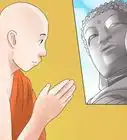wikiHow is a “wiki,” similar to Wikipedia, which means that many of our articles are co-written by multiple authors. To create this article, 33 people, some anonymous, worked to edit and improve it over time.
There are 7 references cited in this article, which can be found at the bottom of the page.
wikiHow marks an article as reader-approved once it receives enough positive feedback. This article received 15 testimonials and 100% of readers who voted found it helpful, earning it our reader-approved status.
This article has been viewed 275,320 times.
Learn more...
Are you Buddhist and haven't gotten around to making a shrine? This article will show you how to build a simple Buddhist shrine.
Steps
-
1Choose a stable place to set the shrine. (Some people use a whole room.) It may be a table or a shelf, but be sure to have it at least above head level based on the usual use of the room.
-
2Make a stand or shelf to support the objects. A simple start is a wooden stand with three levels. This will be the main surface of the shrine, so you may want to put some effort into this.[1]Advertisement
-
3Place the objects onto the shrine. First you will need an image of the Buddha. You can have as many as you like. This will go on the topmost level of the shrine. It is considered 'bad etiquette' to place the Buddha (or Buddhas) lower than any other image in the same room.[2] In the place of an image of Buddha, a mantra written on a piece of paper or similar is perfectly acceptable, and preferred in the Jōdo Shinshū (Pure Land) tradition of Buddhism and in Nichiren Buddhism. Some buddhist schools recommend certain standardized arrangements of images for their lay members, in Japan often as triptychs with the main Buddha surrounded by either bodhisattvas, dharma guardians or lineage masters. This is not necessary, even after Japanese standards, and Chinese-Taiwanese Buddhism is usually less standardized when it comes to home shrines.
-
4If a suitable Buddha image simply cannot be obtained, a picture of Buddha's relics, a stūpa , a Buddhist holy book, a bodhi leaf or picture of the Buddha's footprints may be acceptable.
-
5On the next level, you may place an image of a Buddhist teacher like the Dalai Lama or a small statue of the Chinese Bùdài (the Laughing Buddha, considered to be a manifestation of Buddha Maitreya.) Two guardian images may be an idea to consider: Either the 'lion-dogs' common at the entrance of South Asian monasteries or two dharmapalas/vidyarajas you feel familiar with (Chinese, Japanese and Tibetan Buddhists doesn't use exactly the same palas, and for persons into Tibetan Buddhism or Shingon there may be reasons to choose carefully).
-
6Place offerings on the lowest level or, if you wish, a Buddhist scripture or a bowl of water. Some find a bell or singing bowl on a cushion useful.[3]
-
7Traditional offerings include candles, flowers, incense, fruit or food. However, it is not what you offer that is important: it is that it is done sincerely with a pure heart.[4] Since Buddhist monastics aren't allowed to eat after lunchtime, food, fruit and dairy offerings traditionally – and for symbolic reasons – occur in the morning or shortly before lunchtime. Offerings of water, non-dairy beverages, candles, flowers and incense may, however, occur at other times of the day.
-
8Place a small stūpa on the supporting surface of the shrine, if you wish. You can make a simple stūpa with a small pile of stones. There is no need to go out and buy a costly gold one; that defeats the purpose of Buddhism.
-
9It is traditional to change the offering water every morning, however, the old water should never go to waste. Use it to water a plant or something. A new cup or bowl should be used for this purpose: glass or crystal is preferable, because the clarity of the water represents clarity of the mind. Some Buddhist schools use two water bowls: 'drinking' water and 'washing' water. It is far from wrong to let flowers remain even after withering has begun: The flowers serve to remind you of impermanence.
-
10If you wish, you may offer incense at the shrine when you recite morning ceremony. Touch the tip to your forehead, then light it. See warning.
Expert Q&A
-
QuestionHow can I practice mindfulness as a Buddhist?
 Ira IsraelIra Israel is a Licensed Counselor and Psychotherapist who has been in private practice for over 14 years. He specializes in teaching others about happiness and authenticity. Ira teaches sold-out Happiness and Authenticity workshops at Esalen Institute and Kripalu Center and has written over 400 articles on psychology, philosophy, Buddhism, yoga, film, art, music & literature for The Huffington Post, Good Men Project, Mind Body Green, Thrive Global, and Medium. Ira is also the author of How to Survive Your Childhood Now That You’re an Adult: A Path to Authenticity and Awakening. He attended The University of Pennsylvania and has graduate degrees in Psychology, Philosophy, and Religious Studies.
Ira IsraelIra Israel is a Licensed Counselor and Psychotherapist who has been in private practice for over 14 years. He specializes in teaching others about happiness and authenticity. Ira teaches sold-out Happiness and Authenticity workshops at Esalen Institute and Kripalu Center and has written over 400 articles on psychology, philosophy, Buddhism, yoga, film, art, music & literature for The Huffington Post, Good Men Project, Mind Body Green, Thrive Global, and Medium. Ira is also the author of How to Survive Your Childhood Now That You’re an Adult: A Path to Authenticity and Awakening. He attended The University of Pennsylvania and has graduate degrees in Psychology, Philosophy, and Religious Studies.
Licensed Counselor and Psychotherapist Try different forms of meditation throughout the day. You could concentrate on your breath, practice visualization, or sit without distractions for a few minutes a day.
Try different forms of meditation throughout the day. You could concentrate on your breath, practice visualization, or sit without distractions for a few minutes a day. -
QuestionWhich would best time in the Morning Offering water before Sunshine?
 Community AnswerThe exact time (i.e., 4am or 6:30am) are not what's important. One should wake up early enough to have time to think about the purpose of one's life. When you wake up try to think that I have been in meditation and that your Lama (or the Dalai Lama or Amitabha, Tara or any Bodhidattva) is seated on a lotus on the crown of your head. Think that today I will pray to help all sentient beings even if it is just by being kind, compassionate and generous to those with whom I come in contact. Then rise and go to your shrine. You could light a stick of incense and think; To the Buddha, Dharma and Sangha, I make this offering. Then continue by offering your seven (or 1 or 2 . . .) water bowls, etc
Community AnswerThe exact time (i.e., 4am or 6:30am) are not what's important. One should wake up early enough to have time to think about the purpose of one's life. When you wake up try to think that I have been in meditation and that your Lama (or the Dalai Lama or Amitabha, Tara or any Bodhidattva) is seated on a lotus on the crown of your head. Think that today I will pray to help all sentient beings even if it is just by being kind, compassionate and generous to those with whom I come in contact. Then rise and go to your shrine. You could light a stick of incense and think; To the Buddha, Dharma and Sangha, I make this offering. Then continue by offering your seven (or 1 or 2 . . .) water bowls, etc -
QuestionThe statue I got is holding an empty bowl. Is there anything that I am supposed to put in this bowl?
 Max ThundermanCommunity AnswerIt’s your choice whether you want to put anything in there or not, but usually it’s left clean/empty.
Max ThundermanCommunity AnswerIt’s your choice whether you want to put anything in there or not, but usually it’s left clean/empty.
Warnings
- If you do intend on burning incense or candles, consider the flammability of the covering of the shrine.⧼thumbs_response⧽
- Candles and incense should never be allowed to burn unattended. Consider electric candles or lamps.⧼thumbs_response⧽
- Avoid cheap, low-quality incense. It is generally manufactured in Asia where safety standards are comparatively low and can contain unsafe chemicals.⧼thumbs_response⧽
Things You'll Need
- A Buddha or Bodhisattva image or statue.
- A water bowl
- Flowers/incense/fruit/electric candles.
- A photograph or image of your own Buddhist teacher, if you have one.
- A selection of small stones
References
- ↑ https://www.thebuddhagarden.com/where-to-place-buddha-statue.html
- ↑ https://www.thebuddhagarden.com/where-to-place-buddha-statue.html
- ↑ https://www.windhorse.co.uk/setting-up-a-buddhist-shrine.html
- ↑ https://www.shambhala.com/snowlion_articles/making-offerings-how-and-why/
- ↑ https://www.knowingbuddha.org/dos-and-donts
- The Art of Lovingkindness, by Ven. Master Chin Kung and Ven. Wu Ling.
- The Buddha Book, by Lillian Too.


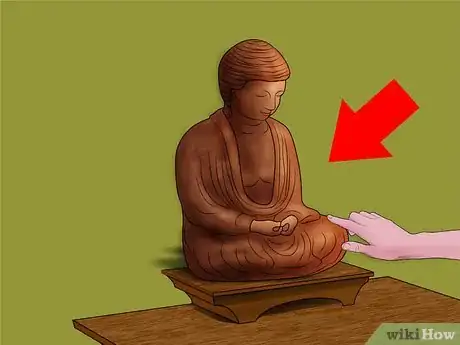

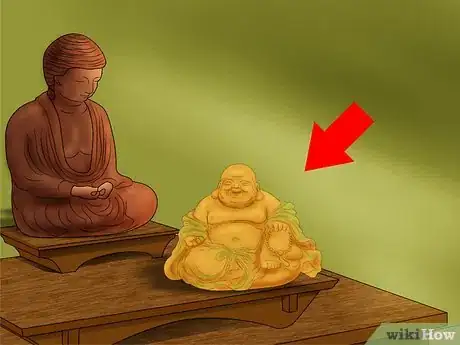
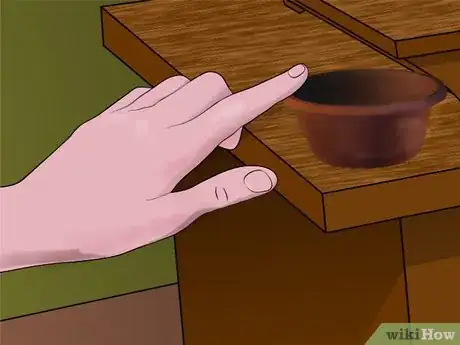

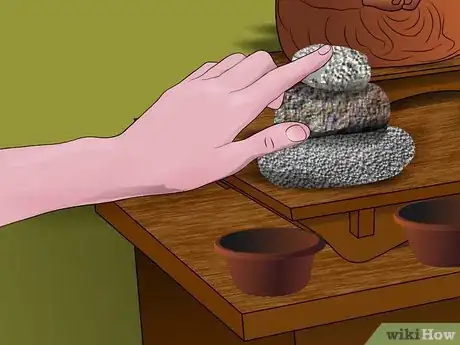




-Step-13.webp)


-Step-10-Version-3.webp)

















-Step-13.webp)
